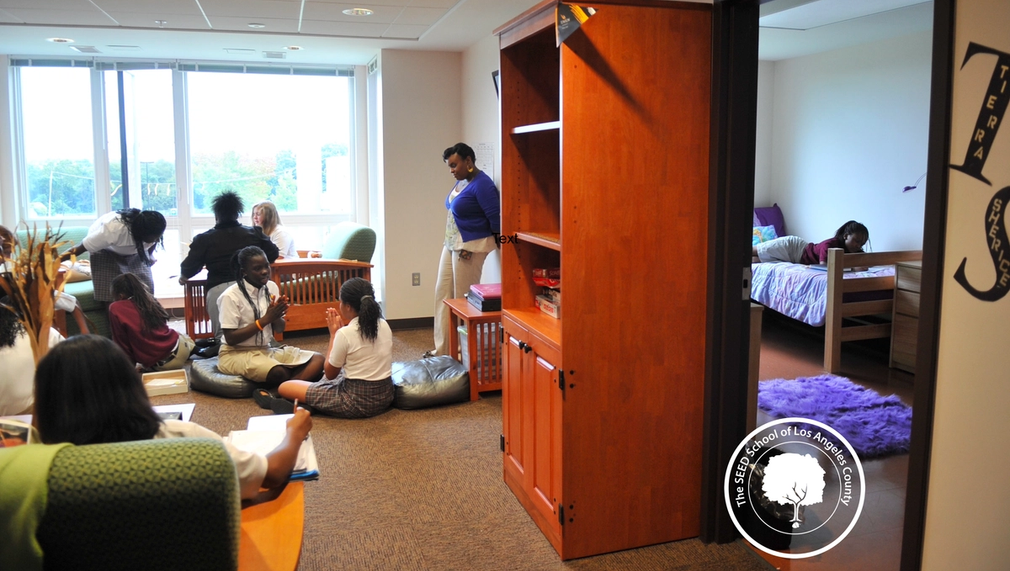Help SEEDLA Students Get to School
SEED students will come from all corners of LA County, arriving to school every Sunday evening and departing for home each Friday afternoon. In the majority of cases, vans are a lifeline for students to be able to attend SEED as their families do not have the means to provide transportation. Also, the vans serve as an extension of SEED programming by creating opportunities to explore and engage an array of interests never thought possible. A grant from LA2050 will provide multiple passenger vans for SEED students this fall.

What is the primary issue area that your application will impact?
Support for Foster and Systems-Impacted Youth
In which areas of Los Angeles will you be directly working?
South LA
County of Los Angeles
In what stage of innovation is this project, program, or initiative?
Expand existing project, program, or initiative
What is your understanding of the issue that you are seeking to address?
A SEED school addresses two key opportunities in LA. Resilient youth served by LA County need an educational model with enhanced services not currently available in traditional schools. Concurrently, LA Metro estimate more than 778,000 new jobs over the next 40 years. There are limited options for underrepresented youth to connect and prepare for the jobs. LA County provides welfare services for nearly 36,000 youth and supervises approximately 10,000 youth through the Probation Department. LA County has determined these youth could benefit from an enhanced academic model that includes educational enrichment and intensive social services to attain a degree and career. In South LA 7% of local high school students are performing at grade level in math and 25-30% are at grade level in language arts. 58% of young people in foster care graduate from high school and only 3% from college. More staggering, 50% of young adults who age out of foster care end up homeless or incarcerated.
Describe the project, program, or initiative this grant will support to address the issue.
SEED LA will be the first public, college-preparatory boarding STEM high school in South Los Angeles for youth who can benefit most. As chartered by LACOE, SEED LA will give priority admission to foster youth, homeless/housing insecure youth, youth entered into the juvenile justice system, or have an immediate family member incarcerated. SEED LA will offer two overarching programs, academic and student life. The academic program will offer STEM, college-readiness activities, will be WASC-accredited and all students will take A-G coursework. In partnership with LA Metro, SEED LA will incorporate curriculum and exposure to careers in global transportation and infrastructure to create a pipeline of skilled graduates ready to pursue a range of opportunities. SEEDs' student life program utilizes the gift of time, 120 hours each week. This extra time can be used on a variety of services, activities, or programming including HALLS (Habits for Achieving Life Long Success) curriculum, mental health checks, mentoring, remedial learning and extracurriculars like gardening, sports, theater, or clubs. Every SEED graduate has a staff member dedicated to their post-secondary success through SEED’s College Transition & Success (CTS) program. SEED’s CTS advisors assist with access to scholarships and emergency financial support, visit graduates at their colleges, and provide professional and personal development mentoring as part of the multi-faceted CTS approach.
Describe how Los Angeles County will be different if your work is successful.
The impact of SEED LA to LA County is tangible. For system involved youth, LA County spends $233,000 per youth annually; SEED LA will cost $40,000 per student for housing and an excellent education. SEED LAs ambitious goal is 75% of its students graduate a four-year college within six years. SEED LA will provide a solid pathway to financial independence. The impact on the individual, family, and community sustains a lifetime. SEED LA is part of a community redevelopment project on blighted property at Vermont Ave and Manchester Blvd left vacant since the civil unrest of 1992. SEED LA will be 147,000 sqft. state-of-the-art campus with 170 dorm rooms, 20 staff apartments, 22 classrooms etc. Serving 400 students, 50% of the students will come from the Vermont Manchester neighborhood and 50% of students from throughout LA County. SEED schools are intentionally located in the communities where its families live. Existing SEED schools are beloved community assets for all to utilize.
What evidence do you have that this project, program, or initiative is or will be successful, and how will you define and measure success?
SEED programming works. The key metric is graduate rates from four-year colleges. 90% of SEED 9th graders graduate from high school. 94% of SEED graduates enroll in college. Students who attend “green” or “yellow” colleges, colleges that support first generation minority students, are graduating college at much higher rates (64%) than the national average (11%). 80% of SEED graduates are first-generation college students. There are very specific academic growth targets set forth in SEEDs charter. The first tool is Network Success Measures (NSM) and the second is School Improvement Plans (SIP). NSMs set benchmarks for success to establish accountability and set goals by capturing student and organizational performance in Math and ELA, Attendance, Student retention, Staff retention and College Application Rates. SIPs focus on priority work and align to SEED Network initiatives. These tools are guided by the schools Root Cause Analysis, school year vision, and are grounded in data.
Approximately how many people will be impacted by this project, program, or initiative?
Direct Impact: 125
Indirect Impact: 500